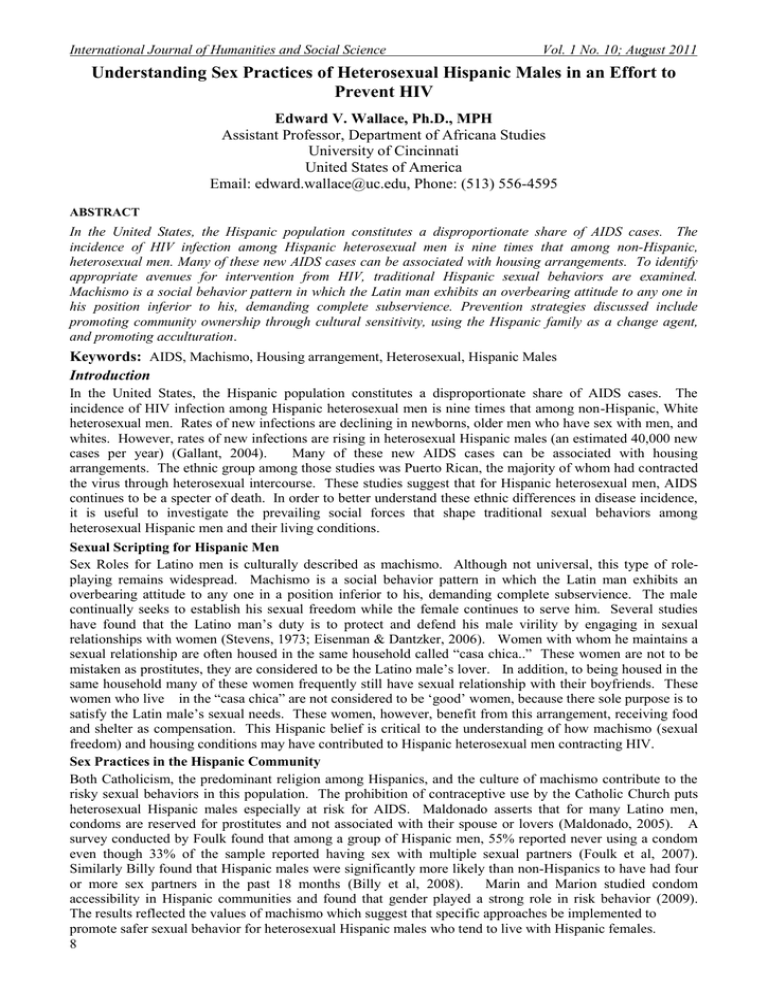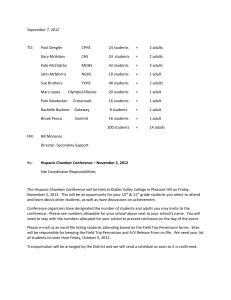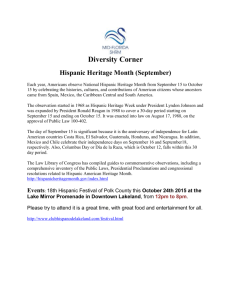
International Journal of Humanities and Social Science
Vol. 1 No. 10; August 2011
Understanding Sex Practices of Heterosexual Hispanic Males in an Effort to
Prevent HIV
Edward V. Wallace, Ph.D., MPH
Assistant Professor, Department of Africana Studies
University of Cincinnati
United States of America
Email: edward.wallace@uc.edu, Phone: (513) 556-4595
ABSTRACT
In the United States, the Hispanic population constitutes a disproportionate share of AIDS cases. The
incidence of HIV infection among Hispanic heterosexual men is nine times that among non-Hispanic,
heterosexual men. Many of these new AIDS cases can be associated with housing arrangements. To identify
appropriate avenues for intervention from HIV, traditional Hispanic sexual behaviors are examined.
Machismo is a social behavior pattern in which the Latin man exhibits an overbearing attitude to any one in
his position inferior to his, demanding complete subservience. Prevention strategies discussed include
promoting community ownership through cultural sensitivity, using the Hispanic family as a change agent,
and promoting acculturation.
Keywords: AIDS, Machismo, Housing arrangement, Heterosexual, Hispanic Males
Introduction
In the United States, the Hispanic population constitutes a disproportionate share of AIDS cases. The
incidence of HIV infection among Hispanic heterosexual men is nine times that among non-Hispanic, White
heterosexual men. Rates of new infections are declining in newborns, older men who have sex with men, and
whites. However, rates of new infections are rising in heterosexual Hispanic males (an estimated 40,000 new
cases per year) (Gallant, 2004).
Many of these new AIDS cases can be associated with housing
arrangements. The ethnic group among those studies was Puerto Rican, the majority of whom had contracted
the virus through heterosexual intercourse. These studies suggest that for Hispanic heterosexual men, AIDS
continues to be a specter of death. In order to better understand these ethnic differences in disease incidence,
it is useful to investigate the prevailing social forces that shape traditional sexual behaviors among
heterosexual Hispanic men and their living conditions.
Sexual Scripting for Hispanic Men
Sex Roles for Latino men is culturally described as machismo. Although not universal, this type of roleplaying remains widespread. Machismo is a social behavior pattern in which the Latin man exhibits an
overbearing attitude to any one in a position inferior to his, demanding complete subservience. The male
continually seeks to establish his sexual freedom while the female continues to serve him. Several studies
have found that the Latino man‟s duty is to protect and defend his male virility by engaging in sexual
relationships with women (Stevens, 1973; Eisenman & Dantzker, 2006). Women with whom he maintains a
sexual relationship are often housed in the same household called “casa chica..” These women are not to be
mistaken as prostitutes, they are considered to be the Latino male‟s lover. In addition, to being housed in the
same household many of these women frequently still have sexual relationship with their boyfriends. These
women who live in the “casa chica” are not considered to be „good‟ women, because there sole purpose is to
satisfy the Latin male‟s sexual needs. These women, however, benefit from this arrangement, receiving food
and shelter as compensation. This Hispanic belief is critical to the understanding of how machismo (sexual
freedom) and housing conditions may have contributed to Hispanic heterosexual men contracting HIV.
Sex Practices in the Hispanic Community
Both Catholicism, the predominant religion among Hispanics, and the culture of machismo contribute to the
risky sexual behaviors in this population. The prohibition of contraceptive use by the Catholic Church puts
heterosexual Hispanic males especially at risk for AIDS. Maldonado asserts that for many Latino men,
condoms are reserved for prostitutes and not associated with their spouse or lovers (Maldonado, 2005). A
survey conducted by Foulk found that among a group of Hispanic men, 55% reported never using a condom
even though 33% of the sample reported having sex with multiple sexual partners (Foulk et al, 2007).
Similarly Billy found that Hispanic males were significantly more likely than non-Hispanics to have had four
or more sex partners in the past 18 months (Billy et al, 2008).
Marin and Marion studied condom
accessibility in Hispanic communities and found that gender played a strong role in risk behavior (2009).
The results reflected the values of machismo which suggest that specific approaches be implemented to
promote safer sexual behavior for heterosexual Hispanic males who tend to live with Hispanic females.
8
© Centre for Promoting Ideas, USA
www.ijhssnet.com
Implementing Safer Sex Practices for Heterosexual Hispanic Males
Selik (2008), states the cofactor of acculturation may exert a considerable influence over safer sex behaviors
among Hispanic males. It is important to distinguish between acculturation and assimilation. Acculturation
refers to a psychosocial change that occurs when an individual from one culture comes into contact with
another culture. Assimilation, on the other hand, refers to the integration of an ethnic minority group into the
social, political, and ideological mainstream of another culture. Herein lies the key to understanding the
impact of acculturation on HIV risk behaviors and its promise in HIV prevention. Acculturation has been
characterized as learning information from the new culture, accepting of skills required by the new culture
(such as language) and integrating attitudes, values, and beliefs from the dominant culture which result in new
social interaction behavior patterns(Marin, 2007). Nyamathi (2008), found that among heterosexual Hispanic
men, those who were acculturated were less likely to have engage in risky sexual behaviors. Those less
acculturated showed more characteristics of machismo, having sex with multiple partners. Marin (2006),
utilized a phone survey to question Hispanic and non-Hispanic males in nine-state region in the Southwest and
the Northeast. They found that married Hispanic men who were less acculturated were more likely to have
two or more heterosexual partners in the previous 12 months than were married non-Hispanic men. The more
acculturated Hispanic men were the less likely they were to have multiple partners.
In the Hispanic world a successful program to reduce HIV transmission among heterosexual Hispanics must
adopt a holistic community approach. One must not forget that the community is a collection of individuals
that share common values, goals, problems, and traditions. Green and Krueter (1991), differentiated between
community interventions and interventions in the community. Community interventions are smaller scale
actions that achieve wider, pervasive community change. Interventions in the community are more focused
and intensive, but seek change within the confines of a more discrete community unit such as schools,
hospitals, or recreational centers. The AIDS messages to heterosexual Hispanic males must be culturally
sensitive. What has yielded measurable success among the mass culture has not worked particularly well for
heterosexual Hispanic males. Cultural sensitivity, in this instance, translates as understanding and changing
the attitude and beliefs about machismo. If heterosexual Hispanic males can be encouraged to abstain from
having multiple partners significant strides can be made to protect Hispanic males from HIV infection.
Social and community agencies on the local level can take the lead in organizing social networks and support
groups for Hispanic males that allow the entire population to benefit. With changed attitudes and beliefs,
hopefully comes changed behavior; with changed behavior comes improved sexual health.
Health education programs, particularly those that attempt to address cultural patterns that place heterosexual
Hispanic males at heightened risk for HIV/AIDS, must incorporate a prominent family component (Table 1).
Few Hispanics would deny the central importance of the family in their lives. Naturally, it can serve as a
natural route for dissemination and ultimately, acceptance and integration of information regarding more
healthy sexual relationships between men and women. Hispanic families recognize emotional attachments
and refer to them as “carino” which translates loosely to a feeling of obligation to protect and nurture loved
ones (Sancho, 2004).
Table I: Specific programmatic elements that involve the family
____________________________________________________________________
1. Disseminate prevention information through community organizations that represent and promote
family life and health such as churches, YMCAs, and Planned Parenthood.
2. Tailor public education messages to emphasize the impact of HIV/AIDS on the family unit and the
potential strength of the family protecting its members from disease.
3. Market health promotion programs in such a way that financial and cultural barriers originating in
predominant family structures are eliminated: low-cost or no-cost activities, provision for childcare,
free transportation to and from activities, and incorporating programs with traditional celebrations and
observances.
Conclusion
It is unrealistic to attempt to eradicate the cultural phenomenon of machismo as a means of preventing HIV
transmission among Hispanic populations. However, there are other outlets for the expression of machismo
that permit heterosexual Hispanic males to display their manhood, their courage, and promote the family
identity in ways that do not place the individual at risk for HIV.
9
International Journal of Humanities and Social Science
Vol. 1 No. 10; August 2011
It‟s recommended that a strategy that permits learning and behavior change while sustaining a sense of
cultural continuity is ideal (2007). A strenuous campaign is needed to educate heterosexual Hispanic males
about the long-term health consequences that result from their own sexual behaviors. Clearly, to successfully
deal with the increase of HIV infection among heterosexual Hispanic males HIV/AIDS education programs
need to be: (a) culturally sensitive, recognizing the multiplicity of Hispanic cultures; (b) accommodating to
the various degrees of acculturation, at times promoting acculturation as a means of community protection; (c)
willing to promote community ownership by changing the attitudes and behaviors of Hispanics, especially
heterosexual Hispanic males; and (d) working within the confines of machismo whenever possible.
References
Bensley, L. B. (2007). Staff development for multicultural competency. In A.C. Matiella (Eds.), The
multicultural challenge in health education (pp. 267-295). Santa Cruz, CA: ETR Associates.
Billy, J.O.G., Transfer, K., Grady, W.R., & Keplinger, D.H. (2008). The Sexual Behavior of Men in the
United States. Family Planning Perspectives, 25, 52-60.
Eisenman, R., & Dantzker, M.L. (2006). Gender and ethnic differences in sexual attitudes at a Hispanicserving university. 133, 153-163.
Foulk, D., Lafferty, J., Ryan, R. (2007). Developing culturally sensitive materials for AIDS education
specifically targeted to migrant farm workers. Journal of Health Education, 22, 283-286.
Gallant, J.E., (2004). HIV Counseling, testing, and referral. American Family Physician, 70, 295-303.
Green, L.W., Kreuter, M. W. (1991). Health Promotion Planning: An educational approach. Mountain
View, CA: Mayfield Publishing.
Stevens, E.P. (1973). Machismo and mariansimo. Society, 10, 57-63.
Maldonado, M. (2005). Latinas and HIV/AIDS. SIECUS Report, 19, 11-12.
Marin, B.V.O. & Marion, G. (2009). Predictors of condom accessibility among Hispanics in
San
Francisco. American Journal of Public Health,, 82, 592-595.
Marin, B.V.O & Gomez, C., & Hearst, N. (2006). Multiple heterosexual partners and condom use among
Hispanic and non-Hispanic whites. Family Planning Perspectives, 25, 170-174.
Marin, G. (2009). Issues in the measurement of acculturation among Hispanics. In K.F. Geisinger (Eds.),
Psychological testing of Hispanics (pp. 235-251). Washington,
DC:
American
Psychological
Association.
Nyamathi, A., Bennett, C., Leake, B. (2008). AIDS related knowledge, perceptions, and behaviors among
impoverished minority women. American Journal of Public Health, 83, 65-71.
Sancho, A.R. (2004). A Multiethnic perspective on comprehensive health education. In A.
C.
Matiella
(Eds.), The multicultural challenge in health education (pp. 103-116). Santa Cruz, CA: ETR Associates
Selik, R.M., Castro, K.G., & Pappaioanou, M. (2008). Birthplace and the risk of AIDS among Hispanics
in the United States. American Journal of Public
Health, 79, 836-839.
10







